site search
online catalog
CLAUBERG SILVER GRIP PRESENTATION SWORD OF CAPT. JAMES WOLFE BRADY, 9th MARYLAND INFANTRY 1863-64 AND PROVOST MARSHAL AT HARPERS FERRY

Hover to zoom





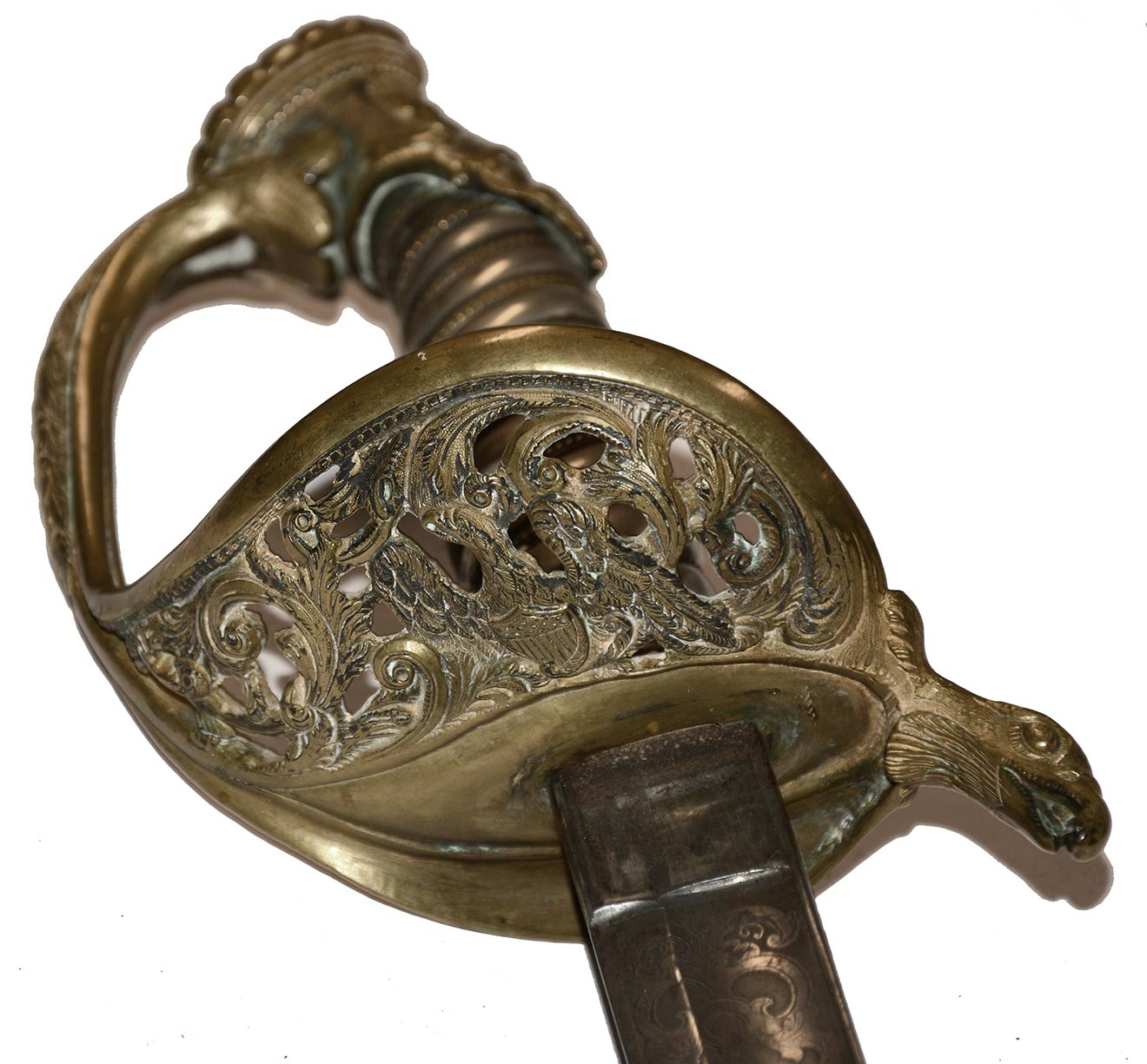







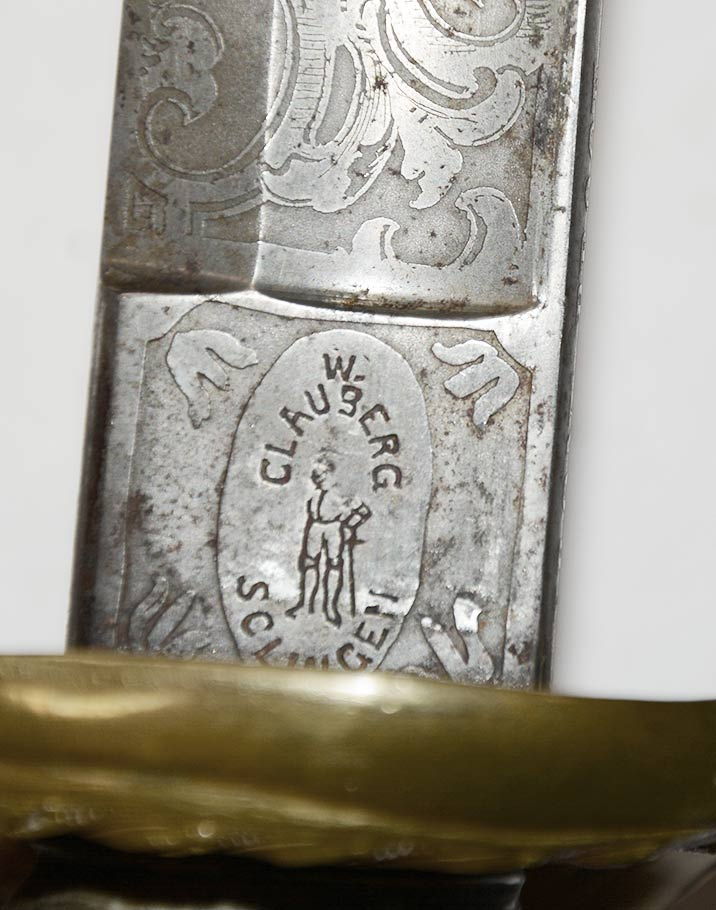
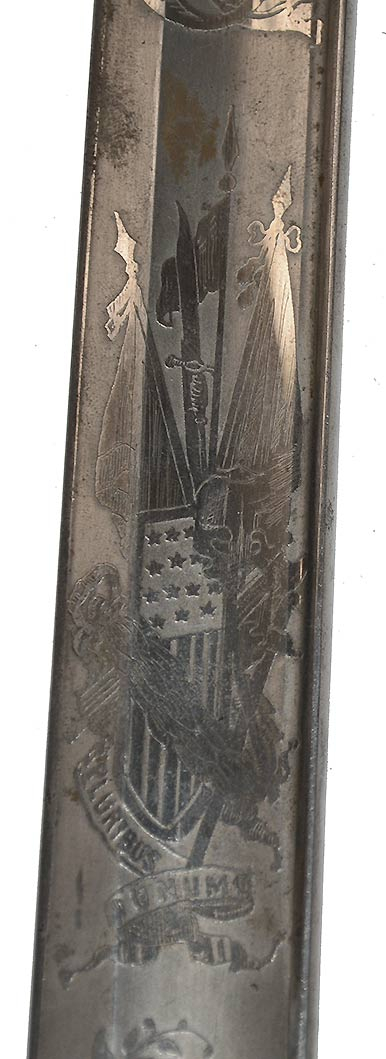

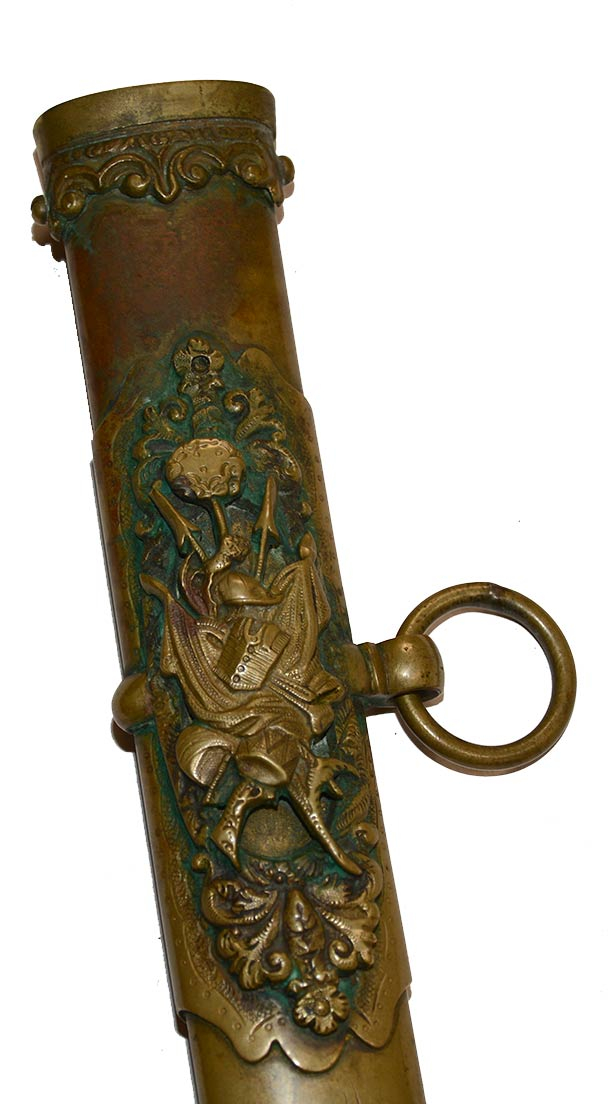
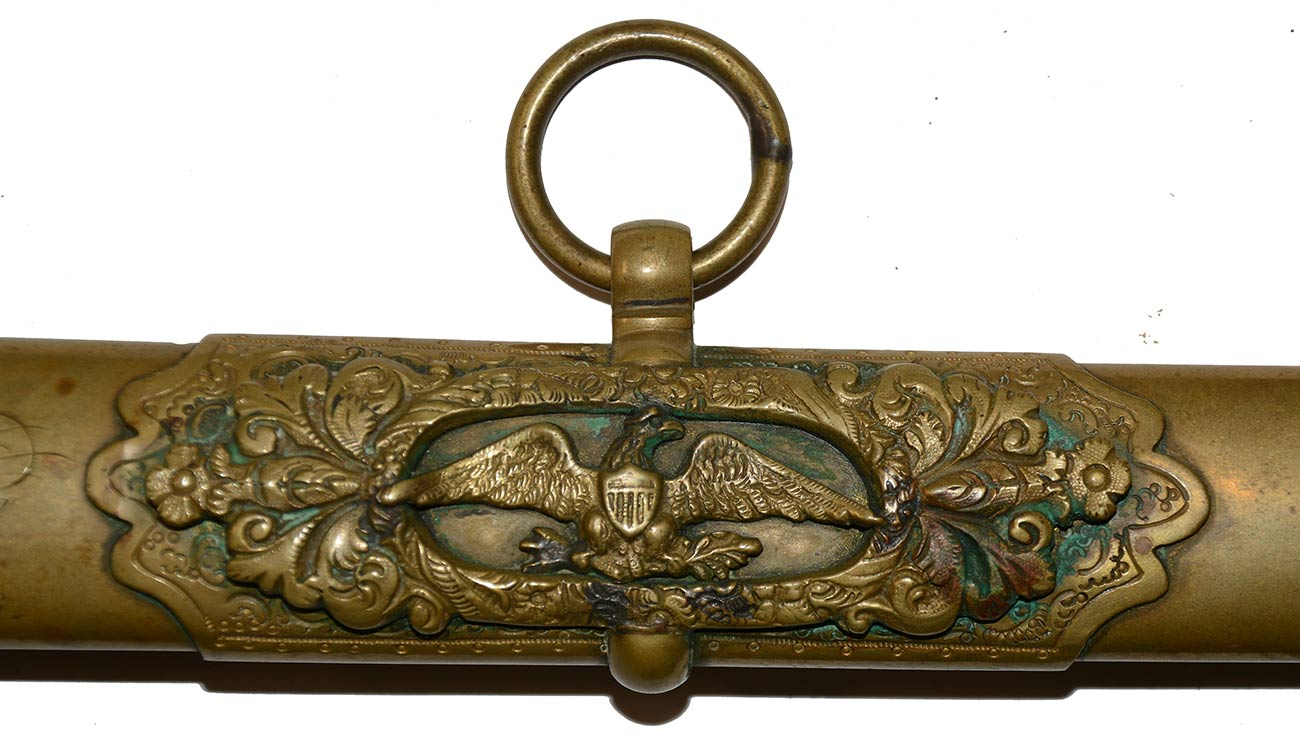


$3,950.00 SOLD
Quantity Available: None
Item Code: 2023-3010
W. Clauberg of Solingen was a prolific supplier of swords and blades to the American market during the Civil War, specializing in higher-end swords, many then etched at the ricasso by an American firm with their own name. Tiffany and Schuyler, Hartley and Graham were just two U.S. firms using their swords or blades. This is a very good example of their M1850 Foot Officer Sword, in that it omits the floating US in the guard, but might also be classed also as a staff and field from its use of a metal scabbard and ornate mounts.
The hilt is deeply cast and chased. The pommel cap was mounted with a gemstone of some sort, likely red, now missing and has a heavily knurled, turban-like base. The face of the pommel bears an eagle with raised wings in high relief on a stippled ground with curling feathery floral scrolls underneath, nested flowers down the back of the knucklebow, and more scrolling floral motifs in the openwork guard with the elements chased both inside and out, coming together on the quillon to form the neck feathers of an eagle’s head jutting forward. The grip is silver, twisted with ridges and grooves with bands imitating brass wire binding.
The blade is stamped on the obverse ricasso with firm name. “W / CLAUBERG / SOLINGEN” with firm’s trademark standing knight, all in a vertical oval. A series of somewhat geometric floral scrolls is followed by a stand of arms with crossed pikes with banners, halberd at center, superimposed US shield and with an E PLURIBUS UNUM ribbon scroll at bottom, over which is a shaded, foliate “US.” This is followed by another series of geometric floral scrolls transitioning into a long, leafy vine or tendril. The obverse has a series of the same style floral scrolls leading up to a wide eagle with spread wings with an E PLURIBUS UNUM ribbon scroll around its neck, on a wreath consisting of an olive and an oak leaf branch. Over that hovers a large trophy of arms, mainly spears behind an oval shield, behind which rises a tall bundle of rods, the fasces of Republican Rome, bound with ribbon reading “IN HOC SIGNO VINCES” (In this sign you will conquer) and topped with a Liberty Cap. The panel then concludes with floral scrolls and vine like the reverse. The etching is fully visible. The blade is a mix of bright metal and the gray of the frosting. The edge and point are good. There is some shallow gray pitting, freckling in some dealer parlance, on either side, extend on the blade flats from the tip about halfway to the tip of the fuller.
The brass scabbard is equally impressive, matches the hilt in having a medium, aged brass patina, and carries a deeply cast and chased throat with C-scrolls, figural ring mounts and screw-fastened, boot-shaped drag. The upper mount incorporates a trophy of arms with spears, banners, trumpet, drum, helmet, and corselet. The middle mount has dense floral motifs bordering a recessed oval with an American eagle with US shield, arrows and olive branch inside it in relief. The long drag has incised C-scrolls and floral scrolls in relief surrounding an officer with boots and kepi advancing with raised US flag clearly showing the stars in its canton, all on a stippled ground matched by the wide band at the top of drag, securing it to the scabbard with a screw on the reverse. The reverse of the scabbard, is relatively plain, though the raised floral motifs on the throat and band of the drag go all the way around and the upper ring mount is incised with a shield shaped panel above and below, like to allow for in inscription.
In this case, however, the inscription has been placed on the obverse, between the ring mounts, certainly to make it more visible, with the recipient’s name in Old English and the rest in script:
“Presented to / Capt. Jas. W. Brady / Company B 9th Md Infy. / Harper’s Ferry, Va. / Oct 28 1863.”
James Wolfe Brady was born in Massachusetts in 1826 and in 1850 was a student at Lawrence Academy in Groton, Mass., when he married Martha Mason, a Baltimore native and moved there with her shortly after. He was studying law, but this put his career plans on hold and he shows up as a bookkeeper in the Baltimore directory of 1860. He apparently resumed his legal studies soon after for an obituary states that he had been reading law in the Baltimore office of Judge Price when he again interrupted his studies to enlist in the army in 1864. He may have served in the militia before this. An undated CDV of him in civilian clothes sold at auction with a red kepi is inscribed by him as “ex Captain Company Governor’s Guard.” It could postdate his service in the volunteers, but that he enrolled as Captain suggests he had previous military experience. He certainly witnessed some action anyway: his obituary stated that Luther Ladd, the first Union soldier killed in action, died in his arms during the attack on the 6th Mass as it marched through Baltimore in April 1861 (thought the paper got the date wrong.)
However that may be, Brady enrolled in the 9th Maryland Infantry on June 17, 1863, mustering into Co. A as the Captain. The regiment was raised for 6 months service during the Gettysburg campaign with the Baltimore “Independent Grays” as its nucleus. In the rush to get the regiment into the field, it left Baltimore for Sandy Hook, MD, before being fully organized and seems to have fielded only nine companies. They became part of the Division of West Virginia, joining troops under French, reoccupying Maryland Heights above Harper’s Ferry and then crossing the river to camp on Loudon Heights. Brady and Company B were initially posted at Duffield’s Station on the Baltimore and Ohio Railroad just northwest of Harper’s Ferry, where in mid-August he was an Acting Provost Marshal and in command of Companies B and C. On September 30 he was assigned to duty as Provost Marshal in Harper’s Ferry itself, where he served until returning to Baltimore for muster out with Company A on February 23, 1864.
Company A was one of only three companies present to be discharged. The other six had been sent to Charlestown in August and on October 18 were captured there by Imboden’s cavalry brigade aiming to draw Union troops away from Lee during his thrust around Meade in the Bristoe Station Campaign. “The Union Army” maintains that, “of the prisoners not more than one-half ever returned home, the others dying in southern prisons.” CWData notes 2 killed or mortally wounded and 4 wounded during their service with 141 taken prisoner. Fox, Regimental Losses notes the two battle deaths and lists 124 other fatalities by sickness, disease, and other causes. We presume the majority were among the captured contingent of the regiment.
We find Brown listed in the 1864 and 1865 Baltimore directories simply as Capt. James W. Brady, without occupation, indicating his pride of service or activity in the militia. In addition to service as captain in the Governor’s Guard at some point, he was Major of the 6th Maryland National Guard- the “Baltimore City Zouaves” in 1867. He never did become a lawyer. After the war he tried the wholesale liquor business for a time, and also the “cracker business” with a James D. Mason, perhaps an in-law. In 1873, however, he took a job as clerk in the Sixth Auditor’s Office in Washington, where he worked until his death in 1896, taking up his legal studies again just long enough to get a Bachelor’s degree in Law from the “National University of Law” in 1878, but seeming never to have passed the bar or practiced. He maintained a residence in Catonsville, MD, at least from 1881 or so, apparently working in Washington during the week and returning home on weekends. He died on a Washington city street car, apparently on his way to work after Christmas at home. He was survived by his wife and three daughters, the only children to survive past infancy out of ten born to the couple. We are aware of a few other items out there that belonged to Brady- a set of captain’s shoulder straps, a hat cord, red chasseur cap, and the civilian photo mentioned above. We show a different photo of him, from a genealogical site, also in civilian clothes, but likewise signed with his military rank, this time as Major, certainly indicating his pride in his military service. He likely carried this sword even then in the militia as a memento of wartime service in the volunteers. [sr] [ph:L]
~~~~~~~~~~~~~~~~~~~~~~~~~~~~~~~~~~~
THIS ITEM, AS WITH ALL OTHER ITEMS AVAILABLE ON OUR WEB SITE,
MAY BE PURCHASED THROUGH OUR LAYAWAY PROGRAM.
CLICK HERE FOR OUR POLICIES AND TERMS.
THANK YOU!
Inquire About CLAUBERG SILVER GRIP PRESENTATION SWORD OF CAPT. JAMES WOLFE BRADY, 9th MARYLAND INFANTRY 1863-64 AND PROVOST MARSHAL AT HARPERS FERRY
Most Popular
Historical Firearms Stolen From The National Civil War Museum In Harrisburg, Pa »
Theft From Gravesite Of Gen. John Reynolds »
Selection Of Unframed Prints By Don Troiani »
Fine Condition Brass Infantry Bugle Insignia »
British Imported, Confederate Used Bayonet »
Scarce New Model 1865 Sharps Still In Percussion Near Factory New »
featured item
MORTON’S BATTERY FLAG OF FORREST’S CAVALRY: EX-GUNTHER COLLECTION, CHICAGO HISTORICAL SOCIETY, & TEXAS CIVIL WAR MUSEUM
This is one of two wartime Confederate flags flown by Capt. John W. Morton consecutively as guidons for his battery or simultaneously with one likely as the battery flag and the other as a personal or designating flag while Morton served also as … (1286-621). Learn More »


